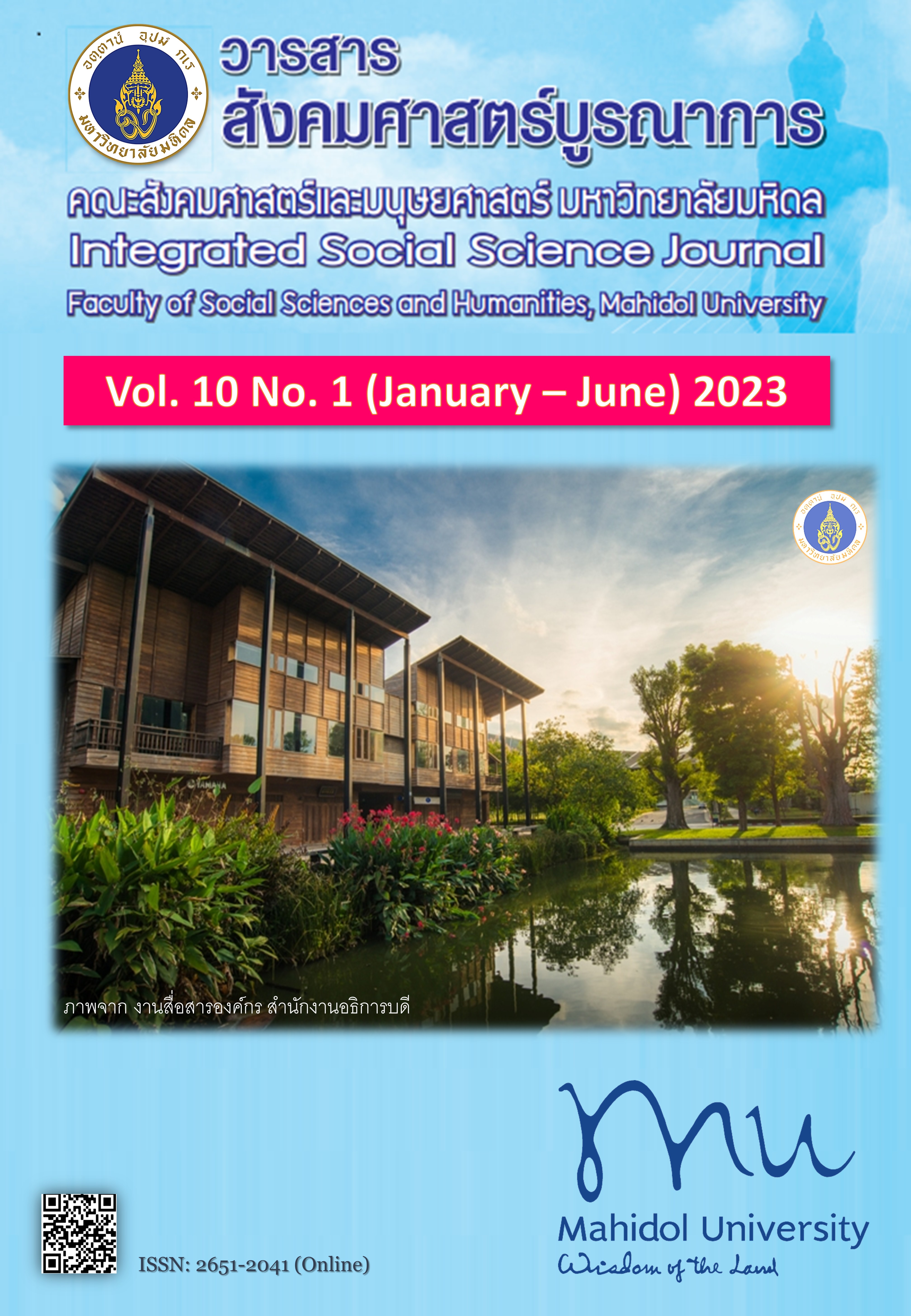การพัฒนาคุณภาพชีวิตของคนไทยและคนลาวบริเวณจุดเชื่อมต่อชายแดนระหว่างประเทศไทยและลาว: กรณีศึกษาสะพานมิตรภาพไทยลาวแห่งที่ 5 จังหวัดบึงกาฬ–เมืองปากซัน แขวงบอลิคำไซ
Main Article Content
บทคัดย่อ
การวิจัยนี้มีวัตถุประสงค์เพื่อศึกษาการพัฒนาคุณภาพชีวิตของคนไทยและคนลาวบริเวณจุดเชื่อมต่อชายแดน จังหวัดบึงกาฬ–เมืองปากซัน แขวงบอลิคำไซ และ ศึกษาแนวทางการยกระดับคุณภาพชีวิตของคนไทยและคนลาว การวิจัยนี้เป็นการวิจัยเชิงคุณภาพ ใช้การสัมภาษณ์เชิงลึกกับผู้ให้ข้อมูลสำคัญจำนวน 12 คน ได้แก่ ประชาชนที่อาศัยอยู่ในพื้นที่บริเวณจุดเชื่อมต่อชายแดนจังหวัดบึงกาฬ–เมืองปากซัน แขวงบอลิคำไซ ฝั่งไทยจำนวน 6 คน และฝั่งลาวจำนวน คน และวิเคราะห์ข้อมูลด้วยการวิเคราะห์เนื้อหา ผลการวิจัยพบว่า ผู้ให้ข้อมูลชาวลาวต่างรายงานว่า ที่ผ่านมา หน่วยงานรัฐบาลลาวไม่ได้ให้ความสำคัญกับการพัฒนาคุณภาพชีวิตของประชาชนชาวลาว ทั้งในด้านชีวิตด้านร่างกาย คุณภาพชีวิตด้านจิตใจ คุณภาพชีวิตด้านสภาพแวดล้อม คุณภาพชีวิตด้านสังคม และคุณภาพชีวิตด้านเศรษฐกิจเท่าใดนัก ส่วนมากประชาชนชาวลาวในพื้นที่จะมีการพัฒนาคุณภาพชีวิตด้วยตนเองเป็นหลัก อย่างไรก็ตาม ผู้ให้ข้อมูลชาวลาวต่างรายงานว่า ตนมีคุณภาพชีวิตที่ดี มีความสุข และมีความพึงพอใจกับคุณภาพชีวิตที่ผ่านมาอยู่แล้ว ส่วนผู้ให้ข้อมูลชาวไทยรายงานว่า ผู้นำชุมชนในพื้นที่มีบทบาทสำคัญในการพัฒนาคุณภาพชีวิตในแต่ละด้าน โดยเฉพาะการปฏิบัติตามแผนพัฒนาเศรษฐกิจและสังคมแห่งชาติไทย อย่างไรก็ตาม ในช่วงระยะเวลาของการก่อสร้างสะพานมิตรภาพไทยลาวแห่งที่ 5 ประชาชนชาวไทยในพื้นที่ได้รับผลกระทบ โดยเฉพาะด้านมลภาวะทางอากาศจากฝุ่นละออง ซึ่งอาจกระทบต่อสุขภาพในระยะยาว และในเรื่องความปลอดภัยตามท้องถนนที่มีความเสี่ยงต่อการเกิดอุบัติเหตุต่าง ๆ การศึกษายังพบว่า ประชาชนของทั้งสองประเทศมองว่า ภายหลังการก่อสร้างสะพานฯ แล้วเสร็จ จะก่อให้เกิดความเปลี่ยนแปลงทางเศรษฐกิจ เกิดการลงทุน การขนส่งสินค้า และการท่องเที่ยวมากขึ้น ประชาชนจะเดินทางได้สะดวกรวดเร็วมากขึ้น ส่งผลให้คุณภาพชีวิตของประชาชนทั้งสองประเทศดีขึ้น ในตอนท้ายผู้วิจัยได้เสนอแนวทางในการยกระดับคุณภาพชีวิตของประชาชนไทย-ลาวในพื้นที่ ได้แก่ การประสานงานกับหน่วยงานรัฐที่เกี่ยวข้องเพื่อแก้ไขปัญหาต่าง ๆ เช่น การเพิ่มไฟส่องทางช่วงกลางคืน การเร่งชดเชยเงินเวนคืนให้แก่ประชาชนที่สูญเสียพื้นที่ทำกิน ตลอดจนการสร้างกิจกรรมร่วมกันของทั้งสองประเทศ เพื่อดึงดูดนักท่องเที่ยวและนักลงทุน ซึ่งจะสามารถยกระดับคุณภาพชีวิตของประชาชนทั้งสองประเทศได้ในท้ายที่สุด
Article Details

อนุญาตภายใต้เงื่อนไข Creative Commons Attribution-NonCommercial-NoDerivatives 4.0 International License.
- วารสารสังคมศาสตร์บูรณาการ มหาวิทยาลัยมหิดล อนุญาตให้สามารถนำไฟล์บทความไปใช้ประโยชน์และเผยแพร่ต่อได้ โดยอยู่ภายใต้เงื่อนไขสัญญาอนุญาต CC Attribution-NonCommercial-NoDerivatives 4.0 International (CC BY-NC-ND 4.0) โดยต้องแสดงที่มา/การอ้างอิงจากวารสาร – ไม่ใช้เพื่อการค้า – ห้ามแก้ไขดัดแปลงเนื้อหา
- ข้อความที่ปรากฏในบทความในวารสารฯ เป็นความคิดเห็นส่วนตัวของผู้เขียนแต่ละท่าน ไม่เกี่ยวข้องกับกองบรรณาธิการวารสารฯ (ซึ่งหมายรวมถึง บรรณาธิการ ผู้ทรงคุณวุฒิในกองบรรณาธิการ หรือ บรรณาธิการรับเชิญ) แต่อย่างใด ความรับผิดชอบองค์ประกอบทั้งหมดของบทความแต่ละเรื่องเป็นของผู้เขียนแต่ละท่าน หากมีความผิดพลาดใด ๆ ผู้เขียนแต่ละท่านจะรับผิดชอบบทความของตนเอง ตลอดจนความรับผิดชอบด้านเนื้อหาและการตรวจร่างบทความเป็นของผู้เขียน ไม่เกี่ยวข้องกับกองบรรณาธิการวารสารฯ
- กองบรรณาธิการขอสงวนสิทธิ์ในการตัดทอน/ปรับแก้ถ้อยคำบางประการเพื่อความเหมาะสม
เอกสารอ้างอิง
โครงการสะพานมิตรภาพไทยลาว แห่งที่ 5 บึงกาฬ-บอลิคำไซ. (2022). ความเป็นมา และความคืบหน้าของโครงการ. บึงกาฬ-บอลิคำไซ: โครงการสะพานมิตรภาพไทยลาว-แห่งที่-5-บึงกาฬ-บอลิคำไซ. https://www.thaipbs.or.th/news/content/320906
เดโช แขน้ำแก้ว, พระสุธีรัตนบัณฑิต และ ปาริชาติ วลัยเสถียร. (2563). มโนทัศน์คุณภาพชีวิตที่ปรากฎในโลกสมัยใหม่. วารสารสหวิทยาการมนุษยศาสตร์และสังคมศาสตร์, 5(3), 800-812.
ชาญชัย อินทรประวัติ. (2547). คุณภาพชีวิต. มหาวิทยาลัยศรีนครินทรวิโรฒ.
ประสิทธิ์ ตงยิ่งศิริ. (2542). การวางแผนและการวิเคราะห์โครงการ. บริษัทเม็ด.
ศูนย์ข้อมูลเพื่อธุรกิจไทยในลาว. (ม.ป.ป.). ความสัมพันธ์กับไทย. https://thaibizlaos.com/lao/about/relations.php
สมบัติ ธํารงธัญวงศ์. (2554). การวิเคราะห์นโยบายสาธารณะ: เอกสารการศึกษารัฐประศาสนศาสตร์. สถาบันบัณฑิตพัฒนบริหารศาสตร์.
สำราญ จูช่วย. (2554). การพัฒนาคุณภาพชีวิตและสังคม. วิทยาลัยราชพฤกษ์.
อนันต์ เกตุวงศ์. (2541). หลักและเทคนิคการวางแผน. มหาวิทยาลัยธรรมศาสตร์.


